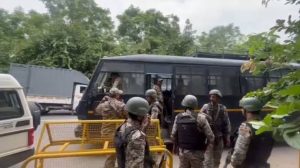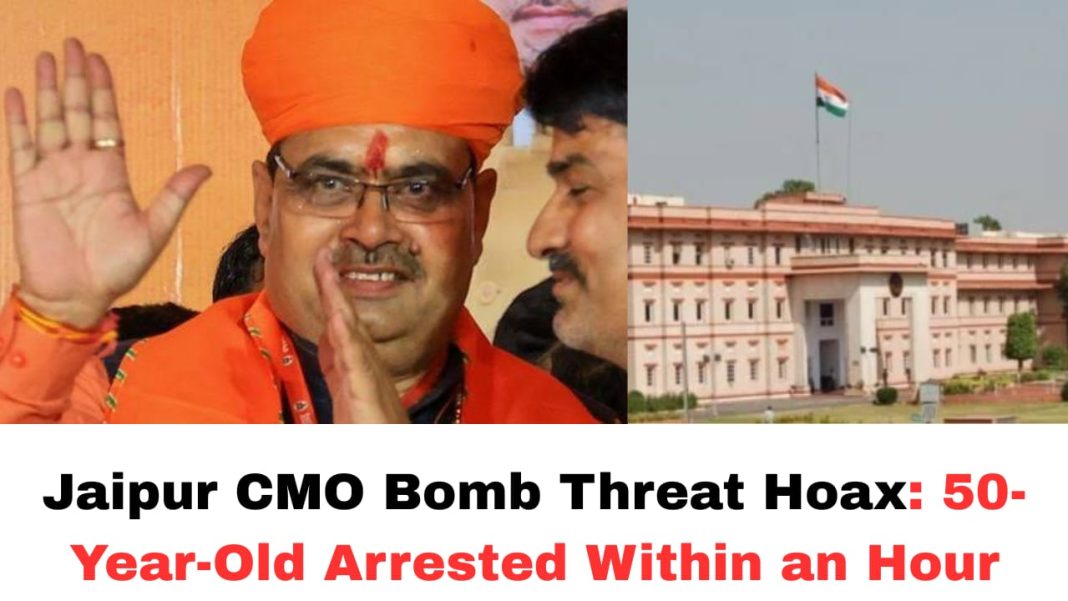Digital News Guru Rajasthan Desk:
Hoax Bomb Threat Targets Jaipur CMO: A Closer Look at the Incident and Its Wider Implications
In a jarring incident on Monday, August 11, 2025, Jaipur was once again jolted by a bomb hoax targeting the political nerve centre of the state. At approximately 12:30 p.m., the police control room received a chilling phone call from a man claiming a bomb had been planted at the Chief Minister’s Office (CMO). Within the hour, law enforcement and bomb disposal teams had swung into action—even as the threat proved to be baseless. The accused, Sanwar Mal Saini, was swiftly arrested at his Jhunjhunu residence, bringing temporary relief amidst growing unease over such scares.
The Immediate Aftermath
The response was swift. Security agencies mobilized senior officials, bomb disposal squads, and conducted a meticulous sweep of the CMO premises—but the search yielded no explosives or suspicious material. Cyber units, using advanced tracing methods, located the call’s origin in Jhunjhunu, and authorities detained the suspect without any resistance.

While the investigation is ongoing, early leads suggest that Saini may have been intoxicated, pointing toward a drunken prank rather than a calculated act. Local reports also indicate he is considered a habitual drinker and possibly a drug addict—factors that may have contributed to his unstable behavior. Still, law enforcement isn’t discounting other angles, and his call logs and background are now under scrutiny.
A Recurring Pattern of Panic-Inducing Hoaxes
This is not Jaipur’s first brush with such a security scare. On July 26, a bomb threat email addressed to both the CMO and Jaipur International Airport triggered a massive security alert—and eventually turned out to be a hoax.
Such incidents form part of a troubling sequence of threats spanning various critical infrastructure, including educational institutions, courts, metro stations, and even hotels. One such episode occurred on July 29, when a bomb threat targeting the Palace School prompted evacuation and a thorough search—a scare eerily similar to the CMO incident.
The Growing Toll of Hoax Threats
While deemed false in nature, these hoax threats carry deep consequences:
- Resource Drain: Every alert triggers deployment of specialized task forces—bomb squads, cyber units, canine squads, and senior officials—draining manpower and directing attention away from more pressing tasks.
- Disrupted Operations: Facilities such as schools and government offices face immediate operational halts. These disruptions ripple outward, affecting not just staff but students, commuters, and the broader public.
- Mounting Vigilance: With recurrent scares, the public grows increasingly anxious, and institutions are forced into sustained high-alert status—raising both economic and emotional costs for all stakeholders.
- Legal Stakes: Authorities caution that hoaxes involving sensitive installations, such as the CMO, are grave offenses. Stringent charges under relevant provisions of India’s Bombs & Explosives laws (BNS) are being brought against perpetrators, potentially including penalties tied to criminal intimidation or misuse of communication tools.

What This Incident Tells Us
Several layers of concern emerge from this episode:
- Infrastructure Vulnerability
Despite heightened security, Bombay Disposal units and cyber centers remain reactive rather than proactive in the face of emergent threats. - Motive and Mental Health Oversight
Officials suggest intoxication and possible addiction may have driven the threat—a lens that underlines gaps in mental health care and social support frameworks for individuals prone to self-harm or mischief. - Preparedness vs. Fatigue
While every threat is responded to with earnest seriousness, repeated false alarms risk causing “alert fatigue” among first responders and the public alike. - Policy Imperatives
The rise in such hoaxes raises critical questions: Should there be stricter penalties? Can cyber-smart tracking systems intercept threats sooner? How might mental health professionals be integrated into threat-assessment and crisis-response frameworks?
Charting the Path Forward
- Strengthening Cyber Forensics: Investments in tracing technologies and inter-state cyber collaboration could enable real-time deterrence and swifter identification of perpetrators.
- Community & Mental Health Support: Integrating social outreach and rehabilitation programs could prevent individuals like Saini from being sidelined incidents rather than signs of deep-rooted problems.
- Public Awareness Campaigns: Educating citizens on the consequences of hoax threats—both legal and civic—can act as a deterrent against future incidents.
- Periodic Drills & Response Updates: Regular mock drills and updated SOPs (Standard Operating Procedures) across schools, government offices, and public spaces can enhance preparedness without inducing societal panic.

In Conclusion
The August 11 hoax serves as a reminder of the fragile balance between security responsiveness and social responsibility. The swift arrest of Sanwar Mal Saini underscores law enforcement’s readiness, but the underlying issues—mental health, legal rigor, surveillance infrastructure—demand longer-term action. As Jaipur and other cities grapple with evolving security threats, effective deterrence will require a blend of technology, legislation, and community engagement—transforming crisis response from reactive to resilient, and from fearful to fortified.
You May Also Read: India-Bloc MPs Arrested Near EC Over Bihar Roll Revisions








